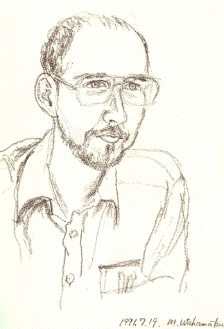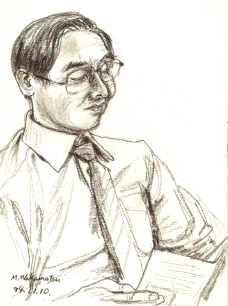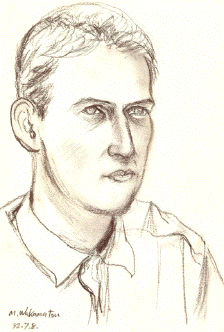
Mr. H.H
(Sketched on July 19 in 1991)

This is H.H, who is working in the Butsuryou group (former Yamamoto
group) of the Physical Science Lab, Basic Research Laboratories.
He arrived in Japan in Jan. 1991 for a two years postdoctoral
stay; before that, he lived in Munich, Bavaria, where he studied
beer gardens, mountain hiking and laser physics. His current interests
include Kabuki, Soba (reportedly he has been to the 1992 world
buckwheat noodle exhibition in a research project concerning Nepalese
buckwheat noodles) and low-threshold semiconductor lasers. Extensive
travel activities and in-depth exploration of his host country
carried him as far as Chiba and Yokohama, although according to
rumors he was also seen in Kyushu and Shikoku.
Although he is fighting a heroical battle against the difficulties
of the Japanese language, it looks like the latter are about to
remain victorious. Moreover, despite holding a Ph.D., he must
still be considered illiterate. But the knowledge of the reading
of the most essential words like 三鷹(Mitaka) and 新宿(Sinjuku) makes
survival possible anyway.
Mr. M.A
(Sketched on November 10 in 1994)
 Nakajima and I
Nakajima and I
Are you aware that the area of Musashino R&D center had been
a land of "a merchant of death" ? There used to be a
Nakajima air plane factory which produced several kinds of engines
for warplanes including a famous Zero fighter plane's.
The first time when I heard of "Nakajima", was when
I was in the third grade, 1944, a year before the end of the World
War II. I remember clearly the day of Nov. 24th, when the air
attack siren blared throughout the area. I returned to my home
quickly and hid in the air-raid shelter which my father had made.
As I ate my lunch in the shelter, I heard strange sounds, jah-goh-shuru-shuru.
The sounds became louder and louder. Suddenly, zunzoon ! The earth
shook violently and our shelter roof collapsed. A 250kg bomb had
hit my neighbor's barn which was about 100m away from my house.
It was the first air attack on Japan from Saipan. Since then,
a B29 frequently attacked Nakajima, usually at midnight. Whenever
the bombers came and the air attack siren sounded, my mother woke
me up and took me in out of Nakajima. 486 people were killed or
injured as a result of those air raids.
At the end of WWII, the Nakajima factory was closed, and part
of it became a school because our school had been damaged. We
tried to make the best of what we had. We moved our school to
the old dormitory for Nakajima workers. The dinning hall became
our gymnasium and we used the papers of from air plane engine
drawings for test papers. We also used the ruins and holes of
the bombs for play and entertaiment.
One day, several years later, we had a school marathon. We ran
around the former area of Nakajima. There were several broken
buildings among them, I noticed a few buildings with a pretty
pond and a garden. I asked my friend, "What is that?"
"It's TSUKEN, NTT communication laboratory, the biggest laboratory
in the Asia", he replied. I commited the name TSUKEN on memory,
an vowed to become a member of the laboratory in the future. 10
years after that, my dream came true, and I have worked here at
the laboratory now for 35 years.
Those experiences made me realize that peace is both important
and wonderful. Now that, a lot of post doctors and researchers
have come here from several different countries to study together,
I am confident that it will never become a land of "a merchant
of death" again.
M.A
Mr. S.F
(Sketched on July 8 in 1992)
 Hello there, my name is S.F.
Hello there, my name is S.F.
I joined the NTT Interdisciplinary Research Laboratories two
years ago. My stay in Japan is almost over now, and when I look
back I'm really surprised that the time passed by so quickly.
I still recall the very first days after arriving in Tokyo, this
confusing and fascinating city. It seemmed to be pretty chaotic
on the first sight but it actually works as precise as a clockwork!
Living in Tokyo for the first time is a bit like being a child
again, discovering new things and places, absorbing new impressions
and especially the sounds all around.
Probably, it is the sounds of Tokyo seemed that will remain with
me for a long time, the train stations for example: in the early
morning a polite (and loud) voice from the speaker greets you
with a friendly 'Ohayo gozaimasu. Densha ga hairimasu, abunai
desu kara', a harp intro in between: 'pling, plong, pling, plong,...'
(everybody who once commuted at Shinjuku station will know the
harp).
Another amazing thing about Tokyo is that it is certainly the
safest place I have ever been to. Foreigners often complain about
a lack of living quality in Tokyo (which is certainly true in
some respects), however, this safety is a special quality which
you hardly find in most other major cities in the world.
But of course, there is not just Tokyo, there is much more: Japan
offers such different places like Hokkaido with lots of snow in
winter and the far south of tropical Okinawa - what a variety
in climate and atmosphere!
Soon, I'll return to Germany and I certainly will miss Japan
and all the friends I found her. But I think it will be a reversible
transition. In other words, I hope to come back!
Mr.
F.F / Mr. S.H / Mr.
Y. H / Mr. H.H / Mr.
M.A / Mr. S.F /
◆Previous page
◆Michio Wakamatsu's home page

 Nakajima and I
Nakajima and I Hello there, my name is S.F.
Hello there, my name is S.F.